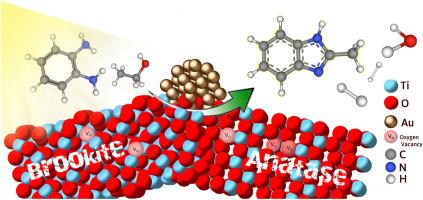锐钛矿钛矿TiO2中氧空位和等离子体金纳米粒子对太阳能驱动2-甲基苯并咪唑和氢协同生产的协同效应
IF 6.3
2区 材料科学
Q2 ENERGY & FUELS
引用次数: 0
摘要
在本研究中,采用改进的溶胶-凝胶法和热处理工艺合成了具有锐钛矿相和板岩相以及氧空位的TiO2异质结构。随后,通过光沉积将金纳米粒子(Au NPs)沉积在TiO2上。详细的结构和化学分析证实了锐钛矿-板岩相的成功形成、Au NPs的有效结合以及Au NPs与TiO2表面氧空位之间的强相互作用。光谱分析显示,金纳米粒子存在局部表面等离子体共振(LSPR),表明其光吸收性能增强。考察了Au-TiO2复合材料在太阳光照射下对邻苯二胺转化为2-甲基苯并咪唑和产氢的光催化效率。值得注意的是,2% Au-TiO2催化剂对邻苯二胺的转化率达到99.7%,对2-甲基苯并咪唑的选择性达到90%,在9 h内H2的产率最高,明显优于2% Au/UV100(商用TiO2)、2% Pd/TiO2和纯TiO2。这种增强的光催化性能归因于表面酸度的增加(来自Lewis和Brønsted酸位)、有效的电荷分离、光电流的增加、电荷转移电阻的降低以及Au NPs与TiO2表面氧空位之间的协同相互作用。这些发现突出了Au-TiO2异质结构在推进太阳能驱动催化应用、促进清洁能源发电和高效有机转化方面的潜力。本文章由计算机程序翻译,如有差异,请以英文原文为准。

Synergistic effect of oxygen vacancies and plasmonic Au nanoparticles in anatase-brookite TiO2 for efficient solar-driven 2-methylbenzimidazole and hydrogen Co-production
In this study, TiO2 heterostructures with anatase and brookite phases, as well as oxygen vacancies, were synthesized using a modified sol-gel method and a heat treatment process. Subsequently, Au nanoparticles (Au NPs) were deposited onto TiO2 through photo-deposition. Detailed structural and chemical analyses verified the successful creation of anatase-brookite phases, efficient incorporation of Au NPs, and strong interactions between the Au NPs and the oxygen vacancies on the TiO2 surface. Spectroscopic analysis revealed the presence of localized surface plasmon resonance (LSPR) from the Au NPs, indicating enhanced light absorption properties. The photocatalytic efficiency of the Au-TiO2 composites was evaluated under solar light irradiation for the conversion of o-phenylenediamine to 2-methylbenzimidazole and hydrogen (H2) production. Notably, the 2 % Au-TiO2 catalyst achieved a remarkable 99.7 % conversion rate of o-phenylenediamine, with 90 % selectivity toward 2-methylbenzimidazole and the highest H2 production rate within 9 h, significantly outperforming 2 % Au/UV100 (commercial TiO2), 2 % Pd/TiO2, and pure TiO2. This enhanced photocatalytic performance is attributed to increased surface acidity (from both Lewis and Brønsted acid sites), efficient charge separation, increased photocurrent, reduced charge transfer resistance and the synergistic interactions between Au NPs and surface oxygen vacancies in TiO2. These findings highlight the potential of Au-TiO2 heterostructures for advancing solar-driven catalytic applications, promoting both clean energy generation and efficient organic transformations.
求助全文
通过发布文献求助,成功后即可免费获取论文全文。
去求助
来源期刊

Solar Energy Materials and Solar Cells
工程技术-材料科学:综合
CiteScore
12.60
自引率
11.60%
发文量
513
审稿时长
47 days
期刊介绍:
Solar Energy Materials & Solar Cells is intended as a vehicle for the dissemination of research results on materials science and technology related to photovoltaic, photothermal and photoelectrochemical solar energy conversion. Materials science is taken in the broadest possible sense and encompasses physics, chemistry, optics, materials fabrication and analysis for all types of materials.
 求助内容:
求助内容: 应助结果提醒方式:
应助结果提醒方式:


